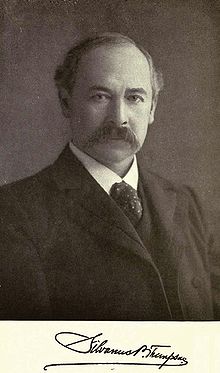Silvanus Phillips Thompson
- Silvanus Phillips Thompson
-

Portraits von Silvanus Phillips Thompson
Silvanus Phillips Thompson (* 19. Juni 1851 in York, England; † 12. Juni 1916) war ein englischer Physiker.
Leben
Seit 1876 war Thompson Dozent und seit 1878 Professor für Experimentalphysik in Bristol, wo er das physikalische Laboratorium einrichtete. Seit 1885 war er Direktor und Professor der Physik am City and Guilds Technical College in Finsbury (London) und ab 1891 Fellow der Royal Society.
Thompson verfasste eine große Anzahl an Aufsätzen aus dem Gebiete der Experimentalphysik, insbesondere der Elektrizitätslehre und Optik, er verbesserte im Jahr 1881 das im Jahr zuvor von Paul Glan entwickelte Glan-Thompson-Prisma[1][2].
Zu Thompsons berühmtesten Veröffentlichungen gehören Calculus made easy aus dem Jahr 1910, sowie die Biografien von Lord Kelvin, Michael Faraday und Philipp Reis. Thompson war der erste Präsident der Röntgen Society (später: British Institute of Radiology).
Werke
- Elementary Lessons in Electricity & Magnetism (1890)
- Dynamo Electrical Machinery (1896)
- Calculus made easy (1910)
Literatur
- J. S. Thompson, H. G. Thompson: Silvanus Thompson, His Life and Letters. Unwin, London, 1920.
- Claus Bernet: Silvanus Phillips Thompson. In: Biographisch-Bibliographisches Kirchenlexikon (BBKL). Band 32, Nordhausen 2011, ISBN 978-3-88309-615-5, Sp. 1420–1428.
- Kurt Jäger, Friedrich Heilbronner: Lexikon der Elektrotechniker. 2. Auflage. VDE-Verlag, 2010, ISBN 978-3-8007-2903-6 (Inhaltsverzeichnis, 125 KB).
Weblinks
Einzelnachweise
- ↑ Silvanus Philipps Thompson: On a new polarising prism. In: Phil Mag. 5, Nr. 12, 1881, S. 349.
- ↑ Silvanus Philipps Thompson: On the Nicol Prism and its Modern Varieties. In: Proceedings of the Optical Convention. London 1905, S. 216.
Kategorien:
- Physiker (19. Jahrhundert)
- Physiker (20. Jahrhundert)
- Hochschullehrer (Bristol)
- Mitglied der Royal Society
- Persönlichkeit der Elektrotechnik
- Brite
- Geboren 1851
- Gestorben 1916
- Mann
Wikimedia Foundation.
Schlagen Sie auch in anderen Wörterbüchern nach:
Silvanus P. Thompson — Infobox Scientist name = Silvanus Phillips Thompson box width = image width = 150px caption = Silvanus Thompson (1851 1916) [Photograph from Thompson s obituary in Proceedings of the Royal Society A, 1917 1918, vol. 94, pp xvi xix. See also… … Wikipedia
Thompson, Silvanus Phillips — ▪ British physicist and historian born June 19, 1851, York, Yorkshire, Eng. died June 12, 1916, London British physicist and historian of science known for contributions in electrical machinery, optics, and X rays. He received both a… … Universalium
Thompson (Familienname) — Thompson ist ein englischer Familienname. Herkunft und Bedeutung Der Name Thompson bedeutet „Sohn des Tom“ (Kurzform von Thomas) und ist damit ein Patronym. Varianten englisch: Thomson dänisch, friesisch, niederdeutsch: Thomsen Bekannte… … Deutsch Wikipedia
Silvanus Thompson — Portraits von Silvanus Phillips Thompson Silvanus Phillips Thompson (* 19. Juni 1851 in York, England; † 12. Juni 1916) war ein englischer Physiker. Inhaltsverzeichnis … Deutsch Wikipedia
Thompson [2] — Thompson, 1) Sir Henry, Mediziner, geb. 6. Aug. 1820 zu Framlingham in Suffolk, gest. 18. April 1904 in London, studierte in London und wurde 1866 Professor der Chirurgie daselbst. Er erwarb sich große Verdienste um die Behandlung der… … Meyers Großes Konversations-Lexikon
Thompson [3] — Thompson (spr. tomms n), Silvanus Phillips, Physiker, geb. 19. Juni 1851 zu York, seit 1885 Direktor des Technical College zu Finsbury (London) und Prof. der Physik; schrieb: »Elementary lessons in electricity and magnetism« (1881; deutsch 1897) … Kleines Konversations-Lexikon
Glan-Thompson-Prisma — Das Glan Thompson Prisma (nach Paul Glan und Silvanus Phillips Thompson) ist ein auf Doppelbrechung und Totalreflexion basierender Polarisator, der unpolarisiertes Licht linear polarisiert (s Polarisation, d. h. die Polarisationssebene ist… … Deutsch Wikipedia
Philip Thompson — could refer to:* Philip Thompson (Kentucky) (1789–1836), U.S. Representative from Kentucky * Philip B. Thompson, Jr. (1845–1909), U.S. Representative from Kentucky * Philip R. Thompson (1766–1837), U.S. Representative from VirginiaSee also:*… … Wikipedia
Michael Faraday — auf einem etwa 1841/42 entstandenen Ölgemälde von Thomas Phillips (1770–1845). Michael Faraday (* 22. September 1791 in … Deutsch Wikipedia
Liste der Biografien/Tho — Biografien: A B C D E F G H I J K L M N O P Q … Deutsch Wikipedia

